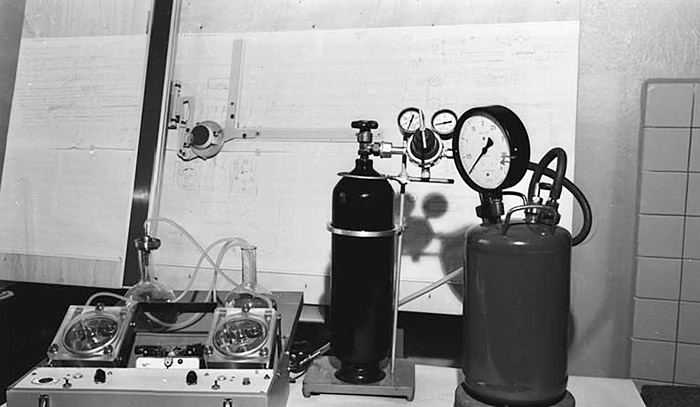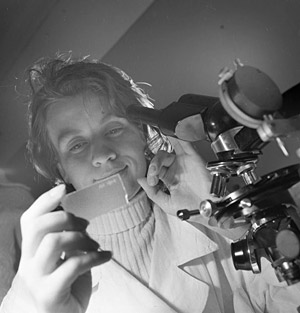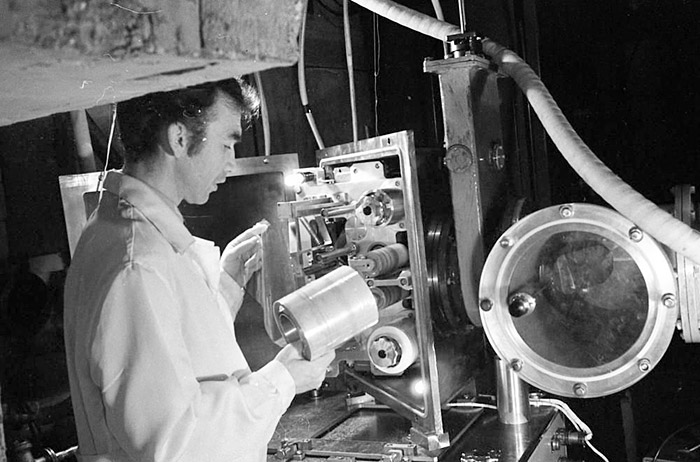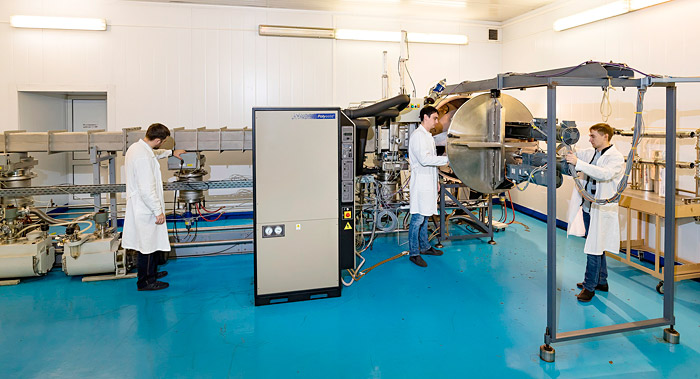
Electronic english version since 2022 |
The newspaper was founded in November 1957
| |
|
Number 45 (4642) |
Science to practice
Half a century with "nuclear filters"
By the decision of the 132nd session of the JINR Scientific Council, the Dzhelepov Prize was awarded to P.Yu.Apel (FLNR) for the development of a new generation of track membranes and their application in medicine and ecology. A few weeks earlier, Pavel Yurievich gave a report on "50 years of track membranes at FLNR" at a seminar at the Flerov Laboratory of Nuclear Reactions. About what moments of impact had happened in his life, how he had come to the laboratory, how track membranes develop today, P.Yu.APEL told our correspondent Olga TARANTINA.
It all started in 1972, when the first experiments on the production of track membranes were carried out in the laboratory. I came to FLNR as a graduate student in September, 1975.
What was the topic of the thesis?
It was on track membranes that were then called "nuclear filters". There's quite an interesting backstory here. It seems that between the sophomore and junior years I bought a book by Elena Knorre "Journey to the World of Transurans", about people who are engaged in the eternal search for truth in the magical city of Dubna near Moscow. It was an interesting, some kind of fantasy world. I still have the book today. I went to the department of radiation chemistry and just as I was finishing it, the professor of our department at the Leningrad Technological Institute K.A.Petrzhak received a letter from G.N.Flerov: please, send us a student to complete the thesis - we have started a new topic "Nuclear filters", a specialist in radiation chemistry of polymers is needed. My supervisor suggested me to go to Dubna. Neither before, nor after the distribution to Dubna from our department had ever been. This was the only case and it happened to me just after that book I had read about FLNR.
The thesis was dedicated to the development of nuclear filters based on polyarylates. Svetlana Pavlovna Tretyakova was my supervisor, I have the kindest memories of this. She helped me at every stage, was very attentive and with the soul. There were practically no tools at that time, work had just started. Of the equipment there were only water thermostats and optical microscopes and nothing else! If I needed the optical spectrum of an irradiated polyarylate, I sent a sample by mail to my friend in Leningrad, he measured the spectrum and then dictated it to me point by point over the phone. After defending my thesis, I stayed here to work.

 |
| Track membranes have started with detectors. Svetlana Pavlovna Tretyakova looks through a glass detector on an optical microscope (1969). |
Svetlana Pavlovna was engaged in nuclear filters and at the same time participated in physical experiments on fusion, where she provided the detection technique. It was time to make a choice between two areas and she suggested me, too, to choose one of them; she was inclined to have me also work with detectors. I decided that working with polymers, with membranes was closer to me. I don't regret my choice at all. Much interesting there can be found in any subject, if it is in development. The task was extremely interesting for a specialist in radiation chemistry because of the "exotic" source of radiation - the heavy ion accelerator. The vast majority of "radiation chemists" work with gamma rays and electrons. In contrast to these sources, an accelerated heavy ion is unique in its capabilities, both for practical applications and for studying the fundamental mechanisms of the radiation interaction with matter.
How did you get interested in chemistry?
In the 9th grade, we wrote an essay on the topic "What do I want to become?" At that time I had not yet finally decided on the choice and wrote in a streamlined way: as a researcher and to work at the intersection of chemistry and physics. And so it happened.
At school, Iya Genrikhovna Solta was the teacher of chemistry, she was a real Teacher. She taught at the university, but then life circumstances brought her to school. She taught us chemistry at the university level. This was one of the reasons, but I also liked chemistry outside of the school curriculum. My father graduated from the Institute of Chemical Technology and we had books on chemical topics at home that aroused great curiosity. My elder brother was also fond of chemical experiments, despite which both the apartment and we ourselves survived. And physics was very popular in the 1960s. My parents subscribed to the journals "Science and Life", "Technology of Youth", "Knowledge is Power", there were so many interesting articles about physics that I always read.
And how did you work in the laboratory at the beginning of this story, when the establishment of the Centre for Applied Physics was not yet suggested?
We were not as strictly regulated as physicists that carried out large experiments as part of teams, where each performer was rigidly assigned to his area of work. It gave some freedom.

The first chamber for constant irradiation of a polymer film 150 mm wide (1975).
What place does FLNR currently occupy in this area among other world research centres?
This topic is quite diverse and it is impossible to be ahead in all its areas. There are things in which FLNR is an undisputed leader, these are methods for development of nano- and microstructures using heavy ions. I think that in these aspects of our laboratory there are no equals today. However, there are many applications in which other laboratories are ahead, especially with some specific applications that require the knowledge and skills of people from other specialties: magnetic phenomena, optical phenomena, all kinds of biological and medical applications, bioinformatics. It is impossible to keep up with everything, especially since few people carry out research. We have staff that produces membranes, yet the actual scientific staff is not that big.
Do the production and scientific staffs of the Centre work independently of each other?
No, we are strongly related to each other. If there are any problems in production, researchers take part in their solution, we look for some kind of optimum, a way out of the situation. Sometimes, it is necessary to produce a membrane that has not been produced before - with a special geometry, or somehow to modify it. In this case, science and production are closely interacted. At the moment, for instance, the cyclotron does not operate very well, for that, there are problems with irradiation, yet it is necessary to execute an order for membranes and they should be of a certain quality. The scientific staff investigates test samples of membranes in order to adjust both the irradiation process and the subsequent processing of the film.
Is there time left for some new research?
Sometimes there is time, sometimes - not at all. Paradoxically, working in the self-supporting department has its advantages. Yes, you spend some time on production tasks, not on science, but there is a payroll and there is no critical dependence on the occurrence or lack of grants for financial support. People in budget research institutes, having a small base salary, should constantly write applications for grants and immediately start to report as soon as they are awarded grants: to write huge reports, to publish a specified number of articles by a certain date that are often fulfilled hastily. And so all over the world, I see a huge number of low quality articles - the result of the fact that the grantees have to publish something.
What I like about our applied research is that it always has a fundamental component. When working on an applied task, one is forced to draw on fundamental knowledge and needs to constantly look for it and draw it from various sources. Applied research develops in different areas, one's basic education is not enough and one needs to educate himself/herself additionally. And vice versa, when working on an applied product, sometimes one discovers previously unknown fundamental patterns. For instance, one solves the problem of producing nanopores of a certain size and shape and suddenly discovers osmotic effects that he/she hasn't known about before. It has been believed that osmosis can only be observed in semi-permeable membranes through which water passes, but salt does not pass. It turns out that even if salt passes through our "track" pores, then under certain conditions, pronounced osmotic phenomena can be observed. Such results provide food for theorists. By the way, having encountered osmosis in practice - a phenomenon known from school and seemingly intuitively simple and understandable - I was forced to study the literature and was surprised to find that the mechanism of osmosis was rather tricky and incorrectly described in popular sources, including Wikipedia and many textbooks. This is an example of how an applied task, as one goes deeper into it, inevitably confronts a researcher with a fundamental one. And there are many such cases.

The current chamber for irradiating films up to 650 mm wide at the IC-100 accelerator.
(End in next issues)
Photo by Yury Tumanov and Elena Puzynina